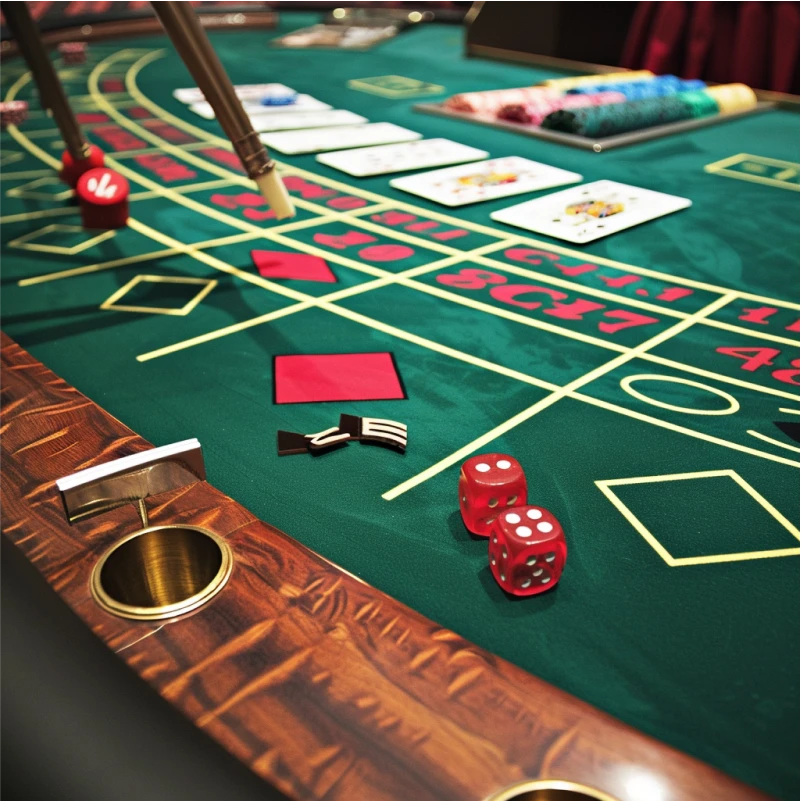What You Should Know about Playing Craps for First-Timers


1.0
Default
When it comes to making the most out of your iGaming experience, exploring other games aside from roulette and blackjack might be the answer to diversifying your gameplay. Have you ever come across a certain casino table in a Las Vegas casino where the dealer holds a stick to set bets?
Well, that dice game is called Craps. It’s been around for hundreds of years and hails from China. In this blog, we’ll show you the basics you should cover as a beginner, what the rules are, and how the dynamics of the game can make or break your odds of winning.
The dynamic of Craps begins with a player known as the shooter who is designated to roll the dice first. The first roll is commonly known as the ‘Come-out’ roll. If you’re playing online, it’s the button with ‘roll’ on it.
Three results are possible based on the numbers that appear after the shooter (or the computer) throws the dice: Natural, Craps/Crapping Out, or Point. Here are some common outcomes when betting Craps:
The shooter must then throw the dice again, trying to roll the exact same number, if they roll the Point. The numbers on the dice don't have to match precisely, though. However, if the player rolls the dice and gets a 7, they lose and "Seven-out," ending the betting round.
The likelihood of this occurring is significantly higher because there are more ways to roll a 7 than any other number.
Learning how to play craps like a pro makes a difference when you study the table and know it like the back of your hand. Each element and marker on the table represents something crucial to your gameplay’s success. Beginners will have a better time grasping the basic moves in real casinos than in online casinos, however, the game flow is quite straightforward. Here are the basics you should keep in mind.
Like any table game in a casino, every game starts with a wager where players prepare their initial bets. In Craps, this is called a ‘Pass Line’ bet. So, what exactly qualifies as a Pass Line bet? Well, it’s simply if you think the dice will land on a 7 or an 11.
A ‘Don’t Pass’ bet is when you think the dice will land on 2, 3, or 12. If the dice land on any of these numbers, the shooter either wins or loses right off the bat, which makes the game incredibly fast-paced and exciting. Meanwhile, any other number rolled sets a 'point', and the game shifts into its next phase where the real strategy begins.
So, your bets have been placed and now you’re ready to throw the dice. This is the time where the shooter will roll the initial wager, otherwise known as the ‘Come Out’ bet. The atmosphere around the table often heats up as everyone anticipates the outcome of the Come Out roll. It's a moment that determines the next steps for all the players involved.
Let’s say you bet on a ‘Pass Line’ bet but the Come Out roll fell on a 7 or an 11. Of course, you win the initial wager. The same goes when you put your money on a “Don’t Pass” bet and the shooter throws a 2, 3, or 12; winner, winner, chicken dinner!
However, if the roll hits any other number, that number becomes the 'point,' and the game gets more interesting as you wait to see if that point will be rolled again before a 7. This stage can stretch the suspense and excitement, turning up the heat as players cheer for or against the shooter.
The "Point" is established when the shooter throws the Come Out roll and the dice land on any other number (4, 5, 6, 8, 9, or 10). After then, the shooter will keep rolling the dice until they either hit the Point number once more or roll a seven, at which point they will either crap out or seven out.
Betting becomes more strategic in this phase, as additional wagering options open up, allowing players to place bets on specific outcomes or numbers. This not only adds layers to the gameplay but also gives participants more ways to engage and potentially win as the dice keep rolling.
Aside from the ‘Come Out’ bet, there are other types of wagers you might want to consider experimenting with while learning the basics of Craps. For instance, you could try the 'Place' bets, where you bet on specific numbers (4, 5, 6, 8, 9, or 10) landing before a 7 is rolled.

There’s also the 'Field' bet, which is a one-roll wager on one of several numbers appearing on the next roll. Lastly, 'Proposition bets' can add a thrilling twist, allowing you to bet on exact numbers or combinations that might come up on the next roll, though these bets typically carry higher risks and rewards.
The shooter will roll the dice after you have put in your wagers, and you can then examine the result. You wager they shoot, and this cycle of events continues until the shooter lands the Point or craps out by rolling a seven. This rhythm creates a dynamic flow to the game that keeps everyone on their toes and fully engaged. As the dice roll, cheers and groans can be heard around the table, reflecting the high stakes and fast pace that make Craps a favorite for many casino-goers.
Wrapping up a round in craps can be tricky yet engaging enough to keep you until the next round. Any wagers on the Pass Line will be successful if the shooter throws the Point before they roll a 7. All wagers on the Pass Line, however, will be lost if the shooter throws a 7 before they roll the Point. However, the winner is the person who placed a Don't Pass wager, which bets against the shooter.
As we mentioned, step five, encouraging more bets during the first round of Craps, can either set you up for success or lead you in the wrong direction. There are several other wagers you can make when playing Craps, and we personally think it’s one of the reasons why people are keen on exploring this dice game more.

Now that you’ve got the basics down, Craps can be an exhilarating addition to your gaming adventures. Dive into the dice action with confidence, explore different betting strategies, and remember, whether you're cheering with the crowd or groaning at a misroll, it’s all part of the thrill. Embrace the chaos and maybe, just maybe, you’ll roll your way to victory.
Learn more about the craps terms to kickstart your betting experience from our blogs at GambleSpot today.

July 26th, 2024
7 Best Horses that Made A Name in Horse Racing
July 24th, 2024
The Role of the Banker in Baccarat - and Why This Could Sway Your Odds
July 19th, 2024
5 Best Slot Games for Art Lovers to Feast Their Eyes on
July 16th, 2024
Fact or Fiction: Pai Gow Edition – What First-time Players Should Watch Out For
July 15th, 2024
Tech and Horseracing: What to Know about Digitizing the Horsebetting Experience
July 9th, 2024
5 Online Casinos with Less than $20 Minimum Deposit You Should Check Out in 2024
July 3rd, 2024
Debunking Common Lottery Myths: What First-time Bettors Should Know
July 2nd, 2024
What to Know About the State of Michigan and Online Poker in 2024
July 1st, 2024
Debunking Common Baccarat Myths: Why You Should Know Better
June 27th, 2024
Understanding the Legal Aspects of Horse Betting in the US: What to Know in 2024Are you sure?
This will delete all chat history, and I will not remember what we were talking about.
✔
Todays Hot Deals